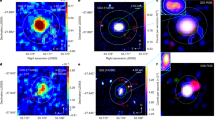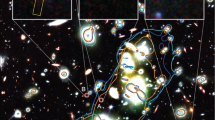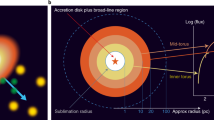Abstract
The Infrared Astronomy Satellite (IRAS) has recently detected a compact far-infrared emission source associated with Vega (α Lyrae)1. This flux appears to be thermal emission from dust heated by the visual/UV luminosity of Vega. Although circum-stellar dust is commonly associated with young, early-type stars2, the characteristics of the emission from Vega are quite atypical. The essential difference is the relatively low temperature of the dust for the observed source size. This low temperature implies that the dust grains producing the far-infrared emission must be very efficient 60/100-µm emitters and must, therefore, be much larger than typical interstellar and circumstellar dust grains. To place more limits on the properties of this far-infrared emission region, we observed Vega at 47 and 95 µm with the Kuiper Airborne Observatory (KAO) on the night of 12–13 August 1983. We report here confirmation of the IRAS results and that the source size may be as large as 46 arc s along some axis.
This is a preview of subscription content, access via your institution
Access options
Subscribe to this journal
Receive 51 print issues and online access
$199.00 per year
only $3.90 per issue
Buy this article
- Purchase on Springer Link
- Instant access to full article PDF
Prices may be subject to local taxes which are calculated during checkout
Similar content being viewed by others
References
Aumann, H. H. et al. Astrophys. J. Lett. (in the press).
Harvey, P. M., Thronson, H. A. Jr & Gatley, I. Astrophys. J. 231, 115 (1979).
Wilking, B. A., Harvey, P. M., Lada, C. J., Joy, M. & Doering, C. R. Astrophys. J. (in the press).
Armstrong, K. A. & Low, F. J. Appl. Opt. 9, 2007 (1973).
Armstrong, K. A. & Low, F. J. Appl. Opt. 13, 425 (1974).
Harvey, P. M., Campbell, M. F. & Hoffmann, W. F. Astrophys. J. 219, 891 (1977).
Moseley, S. H. Astrophys. J. 238, 892 (1980).
Gatley, I., Becklin, E. E., Werner, M. W. & Wynn-Williams, C. G. Astrophys. J. 216, 277 (1977).
Whitcomb, S. E. et al. Astrophys. J. 246, 416 (1981).
Aannestad, P. A. Astrophys. J. 200, 30 (1975).
Lang, K. R. Astrophysical Formulae, 544 (Springer, Berlin, 1980).
Dreiling, L. A. & Bell, R. A. Astrophys. J. 241, 736 (1980).
Jenkins, L. F. General Catalogue of Trigonometric Stellar Parallaxes (Yale University Observatory, New Haven, 1963).
Author information
Authors and Affiliations
Rights and permissions
About this article
Cite this article
Harvey, P., Wilking, B. & Joy, M. On the far-infrared excess of Vega. Nature 307, 441–442 (1984). https://doi.org/10.1038/307441a0
Received:
Accepted:
Issue Date:
DOI: https://doi.org/10.1038/307441a0
This article is cited by
-
Stellar infrared astronomy with EDISON
Space Science Reviews (1992)
Comments
By submitting a comment you agree to abide by our Terms and Community Guidelines. If you find something abusive or that does not comply with our terms or guidelines please flag it as inappropriate.



